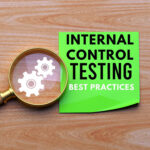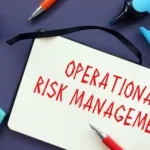In this blog, we delve into the criticality of robust IT risk management frameworks for banks, highlighting frameworks like ISO 27001, FFIEC, OCC, and SOC 1 Type 2. These frameworks help banks safeguard against cyber threats, comply with regulations, and protect customer data. Discover how Anaptyss's Digital Knowledge Operations™ can enhance your IT risk management strategy.
Banks and financial organizations encounter unique challenges and risks in their line of business. Unexpected threats and risks arising from a shift in the political landscape, natural disasters, critical events, cybercrimes, etc., can disrupt organizations’ business strategy, impact both short-term and long-term goals, and lead to bank failure impacting millions of people.
With a significant increase in the risks from cybercriminals, banks need to strengthen their IT or cybersecurity risk management framework to,
- Prevent financial losses
- Protect customer data
- Safeguard reputation
- Avoid penalties by regulators for non-compliance
Enterprise Risk Management Frameworks (EMRF) for Managing IT Risks
Below we have discussed some prominent ERM frameworks that banks or financial organizations can implement or customize to manage and mitigate various cybersecurity or IT risks to protect customer data, build credibility, and meet regulatory compliances.
1. ISO 27001 Risk Management Framework
Banks’ very foundation lies in building trust and credibility. As more and more people are using digital banking solutions and going cashless, the financial sector must take all measures to protect the organization’s and customers’ information from cyber-criminals.
ISO 27001 or ISO/IEC 27001 defines the international security certification requirements and standards representing the best practices and controls for the information security management system, procedures, policies, processes, and systems to oversee the risks related to information assets. These risks include,
- Cyber-attacks
- Hacking attempts
- Data theft
The banking industry can benefit from ISO 27001 as they need to collect significant personal information from customers and store them in electronic data storage devices that remain at risk of theft or cyber-attack.
ISO 27001 requires the organization to identify the security risks in their line of business operation and deploy appropriate controls to mitigate these risks and address the three pillars of information security,
- People
- Processes
- Technology
The ISO 27001 framework help banks or financial institutions develop and maintain information security and management system (ISMS) and controls to effectively identify and mitigate IT security or cybersecurity risks, safeguard sensitive and confidential information, and ensure customer trust.
By implementing the ISO 27001 requirements, banks and financial institutions can get the ISO 27001 certification and increase information security while reducing the efforts required during security audits.
Although ISO 27001 itself is not a security solution, it does encourage the organizations in the financial sector, such as banks, to follow stringent processes and behavior critical to reducing the risk of attacks.
2. FFIEC Risk Management Framework
The Federal Financial Institutions Examination Council (FFIEC) based risk management framework helps organizations identify the risks and verify cybersecurity preparedness. The FFIEC has developed the Cybersecurity Assessment Tool to assist financial institutions to measure the institution’s level of cybersecurity risks and preparedness.
It consists of two cybersecurity assessments,
- Inherent Risk Profile: Refers to identifying the institutions’ inherent risks related to cyber risks at different risk levels:
- Least inherent risk
- Minimal inherent risk
- Moderate inherent risk
- Significant inherent risk
- Most inherent risk
- Cybersecurity Maturity: Refers to determining the financial institutions’ current state of cybersecurity preparedness. This is represented by maturity levels across five domains:
- Cyber risk management and oversight
- Threat intelligence and collaboration
- Cybersecurity controls
- External dependency management
- Cyber incident management and resilience
3. OCC Risk Management Framework
The Office of the Comptroller of the Currency or OCC risk management guidance was one of the ongoing regulatory responses to the 2008 financial crisis issued in October 2013.
OCC framework manages risk using the three lines of defense model as described in the risk management framework —
- Operational management
- Risk management & compliance
- Internal audit
The OCC-based risk management framework guides the institutes in identifying, monitoring, and management of risks across the enterprise.
The OCC also issued a new Model Risk Management booklet of the comptroller’s Handbook defining the eight categories of model risks for banking supervision,
- Credit risk
- Liquidity
- Price
- Interest rate
- Compliance
- Reputation
- Strategic
- Operational
The booklet also guides banks to manage third-party risks and addresses weaknesses related to the use of third parties in model development or related products and services as they can increase operational risks. Especially, when the management does not completely understand the third-part model’s applicability, capabilities, and limitations, if any.
It also highlights the weaknesses in the internal controls and emphasizes the security risks and weaknesses, such as poor API or controls to access, transmit and store customers’ sensitive and confidential information leading to increased operational risks for banks.
4. SOC 1 Type 2 Risk Management Framework
System and Organization Controls (SOC) is an essential risk management framework to ensure accurate reporting for the customers and keep people in the organization accountable and protected. Developed by the American Institute of CPAs (AICPA), the SOC audits aim to audit the internal process, procedures, and controls of the financial institution for managing risks.
SOC 1 Type 2—also known as ‘Report on Management’s Description of a Service Organization’s system & the sustainability of the Design & Operating Effectiveness of Controls’—consists of the same information as SOC 1 Type 1 with different elements.
Soc 1 Type 2 specifically addresses the design, implementation, and testing of the controls. It is specifically applicable for the service industry with a long-running system that is stable and capable of demonstrating the effectiveness of design controls over a period of time, usually for six months, as compared to a specific date in Type 1 but not longer than 12 months.
SOC 1 Type 2 focuses on operational efficacy rather than just the description and design of the controls.
Meet Compliance with Effective Enterprise Risk Management Framework
A well-designed ERMF helps banks’ boards of directors and senior management determine the amount of risk exposure, their risk appetite, and risk controls to address various risks in their business.
It not only helps them efficiently prevent, detect, and mitigate the risks, but also affects investors, customers, and employees’ decisions. By lowering the risks with an effective Enterprise Risk Management Framework, banks can reduce financial losses, and attract more customers and investors.
Anaptyss as a strategic partner helps banks and financial institutions in evaluating and implementing enterprise risk management frameworks based on the organization structure, business goals, technology infrastructure, and available resources.
We use our exclusive Digital Knowledge Operations™-based approach, combining domain expertise and AI/ML-powered digital solutions to help banks address critical enterprise risks across all levels.
Interested in more specific guidance for Enterprise Risk Management and compliance? Write to us: info@anaptyss.com.


















